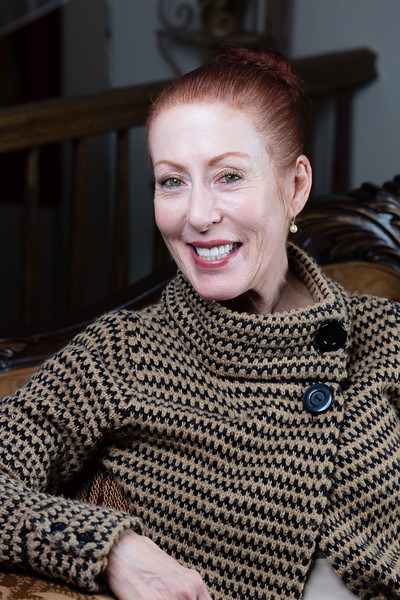- Home
- Editor's Notes
- Current Issue
- Riki Reflects
- Spiritual Traveler
- Starz Emporium
- Classifieds
- Advertise with Us
- Submissions
- Awards
- About Us
- Contact Us
Getting a Grip on Anxiety
By Dr. Denee Jordan, PSY.D
 Dr. Denee Jordan, PSY.D
Getting a Grip on Anxiety:
Enter the New Year without anything holding you back; the process may not be easy, but it is simple.
By Dr. Denee Jordan, PSY.D When it comes to really changing the behaviors, thoughts, and feelings we have been rehearsing for years, the work required can be significant. After all, chances are, if you have an anxiety disorder, you are pretty good at feeling nervous and afraid. Think of all the energy you have used up suffering from your fear. What would happen if you put as much energy into practicing new behaviors? Anxiety disorders are very persistent and can produce tremendous suffering. Anxiety is natural; debilitating anxiety is not. In fact, basic anxiety is necessary. It is our chemical preparation for potential danger. The more anxious we feel, the more we lose our ability to use our human intellect and the more prepared we become to protect ourselves from life-threatening danger; much like a wild animal. I like to think of it as awareness moving from the ‘front’ of the brain (location of rational, reasonable thinking), to the ‘back’ of the brain (location of basic survival). When we lived in the wild, a rapid shift from intellect to ‘fight, flee, or freeze’, was absolutely necessary; however in modern society, it can create a myriad of problems. We are seldom in truly life-threatening situations. The interesting thing is that panic is a reaction to help prevent us from dying, but it is so uncomfortable it feels like we are dying. In fact, a panic attack itself can be much more uncomfortable than the supposed danger, and eventually the panic attack itself becomes the danger. Because panic is at the end of the Survival Spectrum, the part of the brain that can discern the difference between a life-threatening situation and one that isn’t, has already been disengaged. This is why logic can seem so useless when trying to manage a panic attack. It is supposed to be like this so we are in the optimal defensive state. In many ways, it can be compared to going into shock when the body is badly injured. The message from the body and the brain is that there is imminent, life-threatening danger. Eventually, the brain automatically associates this feeling of terror with a ‘trigger’, or cause, in order to avoid this danger in the future. We believe the cause of our panic attack is this trigger; when, in fact, the cause of our panic attack is our lack of ability to recognize and regulate our feelings or fear responses. Panic attacks do not come out of nowhere. They are at the end of a progressive survival continuum. There can also be many contributing factors, besides the trigger, that can intensify the anxiety such as fatigue, hunger, illness, etc.; all of which need to be taken into consideration as well. When looking at anxiety disorders it is very important to see how the stimulus-reaction cycle becomes progressively worse. The reason being is that the more anxious we become, the more we lose our ability to rationally manage our feelings and the less faith we have in our ability to do so. A person becomes afraid of fear itself and begins to live at a progressively more intensive, baseline state of anxiety which, in turn, makes them more susceptible to a full-blown panic attack. Without intentionally breaking the cycle, it frequently happens again and the baseline anxiety goes up even further. Eventually a person completely loses faith in his/her ability to respond in healthy, manageable ways to general stress and/or the trigger. S/he naturally tries to control the perceived danger (going outside, germs, becoming homosexual, eating certain foods, being dirty and so forth) and this leads to avoidant behavior, obsessive thinking, withdrawal and shame. It becomes a progressively vicious cycle. People with Anxiety Disorders can often trace a history of ‘original anxiety’. In other words, there is frequently a significant level of anxiety s/he learned to have in their early years that they have carried with them. Remember, anxiety is a natural response to perceived danger, and perceived danger as a child can be significantly more intense than that of an adult. Children by nature lack the skill to adequately manage significant stress and anxiety and internalize it. Nearly every person I have worked with who has OCD or other anxiety disorders has a history of baseline nervousness. Again, recognition of baseline anxiety levels becomes an important part of recovery. I ask my clients to use a rating scale for their anxiety levels 1 through 5: 1- Without bothersome anxiety 2- Noticeable anxiety- Able to function in usual activities 3- Anxiety is prevalent- Interfering in ability to engage in usual activities 4- Anxiety is extremely uncomfortable - Not able to function in usual activities. Conscious fear of having a Panic Attack 5- Panic Attack- Physical symptoms (rapid heartbeat, shortness of breath, sweaty palms, lightheadedness, terror, and so forth) The use of a scale helps to contain the anxiety and helps a person to view his/her feelings more objectively. The scale is used as a reference point multiple times a day. The person begins to recognize more subtle fluctuations in feelings and practices prescribed skills to regulate them. The person then begins to build back self-trust and sees s/he is capable of experiencing different levels of day-to-day anxiety, recognizing it and regulating it. It is essential that the person sees that it is a loss of faith in their own ability to respond accordingly to people, places and situations that is the problem. They are afraid of their responses, not of the actual trigger. We wire the two things together in the brain when they are actually separate. The good news is that recovery is possible with compassion, courage, patience and commitment. Recovery is very simple, but usually not easy. It involves a series of individualized physical and mental exercises to re-teach the brain how to respond to different levels of anxiety. These exercises are done daily and monitored and supported daily. The basic idea is that ‘Practice makes Progress’. The more a person practices his/her recovery, the more progress will be made. The goal is to restore a person’s ability to recognize and regulate his/her feelings in an effective, loving way. This recognition and regulation is done consistently whether or not there is an uncomfortable level of anxiety. Human beings function better when we remain in (or return to) the ‘front’ of our brains where we are able to calmly, rationally, deal with our lives. We are amazing creatures with amazing brains. We have anxiety attacks as a perfectly natural reaction to our perception of intense danger and our drive to survive. We can learn to respond differently as a natural part of our need to trust ourselves, feel safe, and evolve. Anxiety can be crippling, but it is actually nature’s way of trying to protect us. With compassion and commitment, it is entirely possible to regain the ability to regulate a very natural response to life. It’s simply a matter of realizing that you had the key to recovery within you all along and trusting that you will always have the strength to overcome. ~~~~~~~~~~~~~~~~ Dr. Denee Jordan, PSY.D is a licensed Clinical Psychologist and Marriage and Family Therapist. Over her 26 years of practice she has worked with an extraordinarily varied population, including people diagnosed with Schizophrenia, addictions, eating disorders, anxiety and personality disorders. Her clients have included all walks of life; celebrities, the homeless, artists, and people of all ethnicities and socio economic backgrounds. Dr. Jordan is the founder of Already Well, a progressive approach to treatment that works on the premise that no matter your present circumstance, you are already well. Dr. Jordan also created and directed the Adolescent Treatment program at the STEPS Substance Abuse Treatment Center, a premier facility on the CA West Coast and one of the first in the nation. She has served as director of the STEPS Eating Disorder Recovery Program, the Project Recovery Program, the Phoenix of Santa Barbara Program for Schizophrenia, and the La Casa Mental Health Rehabilitation Center. Today she serves as Mental Health Services Director for the Exceptional Children’s Foundation, which is contracted with the Los Angeles County Department of Mental Health.
|
|
Copyright © 1998 - 2025 Mystic Living Today All rights, including copyright, in the content of these Mystic Living Today web pages are owned or controlled for these purposes by Planet Starz, Inc. Terms of Service Disclaimer and Legal Information For questions or comment, contact Starzcast@mysticlivingtoday.com. Reproduction of this page in any form is not allowed without permission of the author and the owner of this site. All material on this web site, including text, photographs, graphics, code and/or software, are protected by international copyright and trademark laws. Unauthorized use is not permitted. You may not modify, copy, reproduce, republish, upload, post, transmit or distribute, in any manner, the material on this web site. Unless permissions is granted. |



